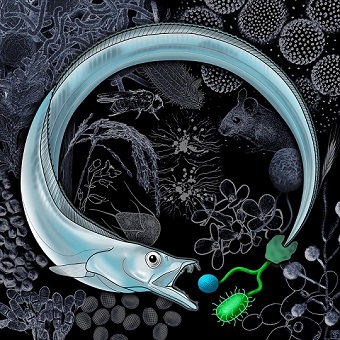GOVERNMENT
Can you eat cells? Supercomputer model predicts which organisms are capable of phagocytosis

New research disputes that 'eukaryote-like' Asgard archaea are cell-eating
A team of American Museum of Natural History researchers has created a supercomputational model capable of predicting whether or not organisms have the ability to "eat" other cells through a process known as phagocytosis. The model may be a useful tool for large-scale microbe surveys and provides valuable insight into the evolution of complex life on Earth, challenging ideas put forward in recent studies. The model and researchers' findings are featured in a paper published today in the journal Nature Ecology & Evolution.
"Phagocytosis is a major mechanism of nutritional uptake in many single-celled organisms, and it's vital to immune defenses in a number of living things, including humans," said co-author Eunsoo Kim, an associate curator in the American Museum of Natural History's Division of Invertebrate Zoology. "But lesser known is the idea that phagocytosis dates back some 2 to 3 billion years and played a role in those symbiotic associations that likely started the cascading evolution toward the more diverse and complex life we see on the planet today. Our research provides some hints as to how phagocytosis first arose."
Prokaryotes, a group that includes bacteria and archaea, are microscopic, mostly single-celled organisms with relatively simple internal structure. Eukaryotes, the group that comprises animals, plants, fungi, and protists (representing assemblages of diverse, unrelated lineages such as amoebozoans and green algae), have generally larger cells that are filled with a number of internal components including the nucleus, where DNA is stored, and energy-generating organelles called mitochondria. Scientific theory dictates that between about 2 to 3 billion years ago a single bacterium merged with an unrelated prokaryotic microbe, leading to the evolution of mitochondria-a key feature of eukaryotic cells. This merger only happened once, and some scientists suggest that the process involved cellular "engulfment." Yet there are no known prokaryotes capable of phagocytosis today. So under what circumstances did the trait arise?
To investigate this long-standing question, the research team used genetic patterns common to phagocytic cells to build a supercomputational model that uses machine learning to predict whether an organism feeds via phagocytosis.
"There's no single set of genes that are strongly predictive of phagocytosis because it's a very complicated process that can involve more than 1,000 genes, and those genes can greatly vary from species to species," said lead author John Burns, a research scientist in the Museum's Sackler Institute for Comparative Genomics." But as we started looking at the genomes of more and more eukaryotes, a genetic pattern emerged, and it exists across diversity, even though it's slightly different in each species. That pattern is the core of our model, and we can use it to very quickly and efficiently predict which cells are likely to be 'eaters' and which are not."
Because many eukaryotes, such as some green algae, can be "picky"-only eating under certain conditions-it can be hard to determine whether they are capable of phagocytosis simply by watching them under a microscope. This new model can help microbiologists make a quick assessment, and it may also be valuable for use in large DNA sequencing projects that involve multiple unknown microbial species, for example, surveying sea water samples.
The researchers applied the model to a group of "eukaryote-like" microbes called Asgard archaea. In recent years, some researchers have proposed that Asgard microbes might be living relatives of long-sought-after microbes that merged with the bacterium that became mitochondria. But the researchers' new work finds that these microbes most likely do not use phagocytosis. They also used the gene set developed as part of the model-building process to look more closely at the ancient lineages of archaea and bacteria, and found that, as a whole, neither group on its own has the genes required for phagocytosis. While the new work eliminates one scenario for the birth of mitrochondria-that Asgard archaea engulfed a bacteria-many other options remain.
"When you tease apart the components of these predictive genes, some have roots in archaea, some have roots in bacteria, and some are only unique to eukaryotes," Kim said. "Our data are consistent with the hypothesis that our cells are a chimera of archaeal and bacterial components, and that the process of phagocytosis arose only after that combination took place. We still have a lot of work to do in this field."

 How to resolve AdBlock issue?
How to resolve AdBlock issue?